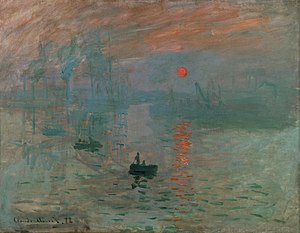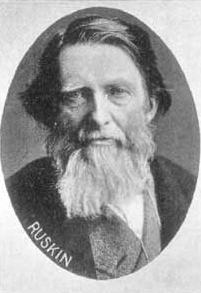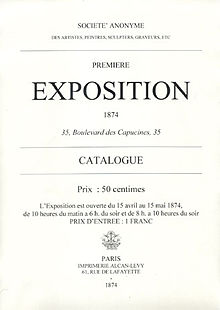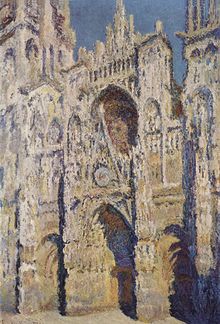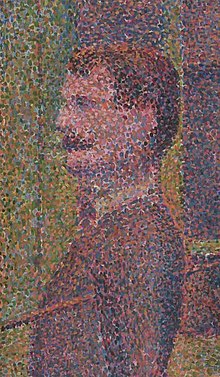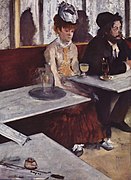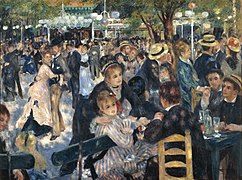Impressionism
Impressionism is an artistic movement initially defined for Impressionist painting, from the derogatory comment of an art critic (Louis Leroy) before the painting Impression, Rising Sun by Claude Monet, generalized to others exhibited at the salon of independent artists in Paris between April 15 and May 15, 1874 (a group that included Camille Pissarro, Edgar Degas, Pierre-Auguste Renoir, Paul Cézanne, Alfred Sisley, Berthe Morisot).
Although the adjective «impressionist» has been applied to label products of other arts, such as music (musical impressionism —Claude Debussy—) and literature (Impressionist literature; Goncourt brothers), its particular defining features (light, color, brushstrokes, plenairism) make it very difficult to extend, even for other plastic arts such as sculpture (Auguste Rodin) and architecture; in such a way that it tends to It can be said that impressionism in the strict sense can only occur in painting and perhaps in photography (pictorialism) and cinema (French impressionist cinema or première avant-garde: Abel Gance, Jean Renoir; son of the impressionist painter Auguste Renoir).
The Impressionist plastic movement developed from the second half of the XIX century in Europe —mainly in Normandy (Giverny and the Norman coast mainly)—characterized, broadly speaking, by the attempt to capture light (the visual “impression”) and the moment, regardless of the identity of what projected it. That is to say, if their predecessors painted forms with identity, the impressionists painted the moment of light, beyond the forms that underlie it. It was key to the development of later art, through post-impressionism and the avant-garde.
Representatives
- Eugène Boudin (1824-1898), one of the precursors of impressionism and master of Monet in his youth.
- Gustave Courbet (1819-1877), one of the forerunners of Impressionism.
- Édouard Manet (1832-1883), never belonged to the Impressionist Group.
- Edgar Degas (1834-1917), founding and historical member of the Impressionist Group.
- Paul Cézanne (1839-1906), founding and historical member of the Impressionist Group.
- Claude Monet (1840-1926), founding and historical member of the Impressionist Group.
- Pierre-Auguste Renoir (1841-1919), founder and historical member of the Impressionist Group.
- Berthe Morisot (1841-1895), founder and historical member of the Impressionist Group.
- Francesco Filippini (1841-1870), precursor and founder of the Italian Impressionists.
- Mary Cassatt (1844-1926), member of the Impressionist Group.
Precedents
English Landscape Artists
In the first half of the XIX century, at the height of Romanticism, Joseph Mallord William Turner and John Constable —English landscape painters — would lay the foundations on which the Impressionists would later work.
The Impressionists would take their taste for transience, blurred and vaporous surfaces and the blurring and mixture of yellows and intense reds from Turner, as well as the description of a visual moment beyond formal description, in which light and colors make a more powerful "impression." The greatest exponent of these characteristics is found in Rain, Steam and Speed (1844) National Gallery in London, a painting considered the origin of Impressionism. The Impressionists eliminated the sublime component of Turner's work, typical of romantic painting.
Edouard Manet
A key author among the precursors of the Impressionist movement is Édouard Manet. Two of his works are essential in understanding his influence on the group.
In his Lunch on the Grass Manet presents a still life. Despite the fact that the figures represented are human, the author works the painting as if it were a still life. This is evidenced by the lack of connection of some characters with others: three characters are dressed while the fourth is naked; Eyes never meet even though there is a character speaking and the arrangement in the foreground (basket and food), in the second (group) and third plane (woman in the water) is merely compositional. This work will influence the impressionists in the neglect of the model and the narration.
On the other hand, The Folies-Bergère bar will demonstrate the desire to deal with light phenomena by introducing a mirror in the background that reflects the entire depth of the room and the large chandeliers, artificial lighting which creates a diffused and less direct light and, therefore, more difficult to paint, reminding us of Renoir's festive scenes.
Corot and the Barbizon School
The Impressionists had a precedent in Camille Corot and the Barbizon School. Corot played an important role in the formulation of Impressionism, because he renounced many of the formal Renaissance devices, preferring to concentrate his attention on flatter, simpler spaces and brighter surfaces.
And although unlike the Impressionists, he never quite fragmented light into its chromatic components and always organized and simplified its shapes to achieve a certain classical composition, he also frequently used a high tonal key, as well as, in terms of generals, a new freshness and spontaneity in the official Salon.
History
Beginnings
Before Impressionism, the artistic framework was dominated by eclecticism, to which the generation of stylistic breaks responded, a series of breaks that would give modern art its own personality. The first of these or, if you prefer, its preamble, is Impressionism, a movement, the result of a long evolution, which definitely places the century XIX under the sign of the landscape and looking for a new language based on extreme naturalism.
Tends to use pure, unmixed colors with increasing frequency, especially the three primary colors and their complements, and to dispense with blacks, browns, and earth tones. They also learned to handle paint more freely and loosely, without trying to hide its fragmented brushstrokes, and light became the great unifying factor of figure and landscape.
Flowering and first exhibition
The year 1873 will mark a characteristic turn of Impressionism: the transition from the preparatory phase to the flowering phase. The scores were forgotten and the work advanced. Pissarro and Monet had made studies of mist-shrouded buildings in London; Alfred Sisley, even more vaporous, had gone ahead of them down that road; Renoir was, for the moment, under the total influence of Monet; and Edgar Degas began to treat the tutus of his ballerinas in the same way that Monet or Renoir did the flowers of the field.
All the Impressionists, including Berthe Morisot, were already aware of forming a group and having the same objectives to defend. The first public appearance of her as such was brewing. In order to weigh more in the eyes of the public, they tried to attract other artists and founded a Limited Company of Painters, Sculptors and Engravers, which in 1874 finally managed to organize an exhibition in the salons of the photographer Nadar. A total of thirty-nine painters participated with more than one hundred and sixty-five works, ten of which were by Degas, the group's largest individual contribution, and among which was the already legendary Impression: Rising Sun by Monet who, mockingly quoted by a critic, gave the group its name.
Dissemination
Impressionism spread throughout Europe, among other things, thanks to its ease and speed.
Impressionist technique and aesthetics
Pure colors
The second half of the XIX century witnessed important scientific and technical developments that allowed the creation of new pigments with which painters would give new colors to their painting, usually in oil. The painters achieved a purity and saturation of the color until then unthinkable, sometimes, with non-natural products. From the use of pure or saturated colors, the artists gave rise to the law of chromatic contrast, that is to say: "every color is relative to the colors that surround it", and the law of complementary colors enriching the use of pure colors under contrasts, generally of cold and warm. The shadows went from being made up of dark colors to being made up of complementary colors that, at the same time, created the illusion of depth. The main characteristic is the use of complementary, from light to shadow and in the same value, this is called color modulation. We can say that, breaking with the classical dynamics of chiaroscuro, where the contrast is given by value, this is called color modeling; the contrast between light and dark is what generates the illusion of depth. They also enriched the plastic language by separating the resources of drawing and applying only the resources of painting: that is, color. To define the shape, its richness of color allowed them to refine the volume through more nuances of light, creating lights within the shadow areas and shadows within the illuminated areas, resorting solely to the use of color. A good example of the use of saturated colors for lights and shadows can be found in the painting The Rouen Cathedral by Claude Monet. This use of colors would exert a notable influence on the first avant-garde, especially on the fauvism of Matisse or Gauguin.
Gestalt Brushstroke
Although the Gestalt theory appeared later, the Impressionist painters plastically showed what Gestalt psychology would later come to demonstrate psychologically and scientifically: perceptually, if certain conditions are met, unconnected parts give rise to a unitary whole. The use of small brushstrokes of pure colors resulted in a vibrant whole; and, although the isolated brushstrokes did not obey the local shape or color of the model, as a whole —when perceived globally and unitarily— they acquired the necessary unity to perceive a defined whole. This resource was taken to the maximum by the neo-impressionists, also known as pointillists such as Seurat or Signac.
Shape
The description of the form, relegated to the background and left to the hands of the draftsman and not the painter, is subordinated to the definition of the particular lighting conditions. That is why Impressionist artists will seek picturesque lighting conditions as challenges to their genius, resorting to interior lighting by artificial light —like Edgar Degas and his dancers—, filtered natural lighting —like Auguste Renoir and the light passing through the leaves of trees— or outdoor lighting with reflections in the water or crowds of people like Claude Monet. The painting begins to deal with what is intrinsic to it: light and color and in no case to the formal description of the volume inherited from classicism; Thus the forms are diluted, mixed or separated imprecisely depending on the light to which they are subjected, giving rise to that "impression" that gives the movement its name.
Variations on the impressionist aesthetic
Not all the painters in the group were the same, and far from it, faithfully orthodox with respect to the Impressionist aesthetic. Eduard Manet's solid structures of light and shadow were done mostly indoors, after much preliminary study, and have the formal diction of studio art, not the freshness of plein-air painting. Atmosphere and local color were by no means his primary objectives, and when he represented what appears, at first glance, to be an "impressionist" subject, he was capable of ladening it with so many ironies and contradictions that it clouded all its immediacy.
Leaving aside Berthe Morisot, the painter of the group that comes closest to it is Edgar Degas, whose painting is difficult to understand due to its sharp intelligence, its intriguing mixtures of categories, its unconventional influences and, above all, its so “coldness”, that cold and precise objectivity that was one of the masks of his indefatigable power of aesthetic deliberation.
In fact, no painter in the group is as purely Impressionist as Claude Monet. In his work the dominant factor is a clear effort to incorporate the new way of vision, especially the character of light, while the composition of large masses and surfaces serves only to establish a certain coherence.
For his part, Renoir is the painter who convinces us that the aesthetics of Impressionism was, above all, hedonistic. Pleasure seems the most evident quality of his work, the immediate and burning pleasure that painting produces in him. He was never overwhelmed by problems of style and went so far as to say that the object of a painting is simply to decorate a wall and that is why it was important that the colors be pleasing in themselves.
Camille Pissarro was undoubtedly the least spectacular of the Impressionists because he is a tonal painter rather than an essentially colourist. But, dean of Impressionism, he played an important role as a moral conscience and artistic guide.
And finally, working sometimes with Renoir and sometimes with Monet, there was Alfred Sisley, influenced by both. Throughout his life he faithfully followed the guidelines of the impressionists but he never gave up "the hunt for the motif" and always let himself be carried away spontaneously, with a faculty of direct communication, by an underlying Romanticism full of poetry.
The first official manifestation of impressionism was the exhibition organized in 1874 in the studio of the photographer Nadar, outside the official Salon, by a group of painters (Bazille, Cézanne, Degas, Monet, Morisot, Pissarro, Renoir, Sisley), whose works motivated the general rejection of critics and the public. A painting by Monet, Impression, Rising Sun, gave rise to the name «Impressionism», created with pejorative intent by the critic Leroy. This first show marked the end of a training period begun some fifteen years earlier by a group of artists from the Swiss Academy (Pissarro, Cézanne, Guillaumin, Monet, Renoir, Sisley, Bazille), who, interested in breaking with the traditional pictorial approaches and from the innovations of Corot and the landscape painters of the Barbizon school, they focused on painting in the open air and sought to capture the changing luminosity of landscapes and human figures. During this initial period, the figure of Manet was fundamental, who, with The picnic and Olympia , became the standard bearer of anti-academicism. After the first exhibition, the Impressionists gathered their works on seven more occasions (1876, 1877 —which captured the moment of greatest cohesion of the movement—, 1879, 1880, 1881, 1882 and 1886), throughout which they stopped participating some of the pioneering artists (Cézanne, Monet, Renoir, Sisley) and new names were added (Cassatt, Gauguin, Redon, Seurat, Signac). The first major publications on the new trend were articles by Zola (in L'Évènement) and by Castagnary (in Le Siècle), La nouvelle peinture (1876), by Duranti, and the History of Impressionist Painters (1878), by Duret. Impressionism also created a school in other European countries; they are to emphasize Zandomeneghi in Italy; in Spain, Regoyos, late 1915, Eugenio Hermoso, La Juma, la Rifa and their friends, and 1920 by Sorolla, Claus in Belgium, Grabar and Isaac Levitán in Russia, Steer and Sickert in Great Britain and Sargent, Hassam and Twachtman in USA
We have to remember that it also involved the impressionist musicians, as opposed to the drama of the romantics, they tried to allude more than to affirm and they expressed themselves more through harmonic dissociation and the timbre and color of the instruments than through of the melody. Its greatest representatives were C. Debussy and M. Ravel, although authors such as P. Dukas, F. Delius, A. Caplet, F. Schmitt or R. Vaughan Williams were also influenced by this technique.
Impressionist painters
- Frédéric Bazille
- Gustave Caillebotte
- Paul Cézanne (considered Impressionist, although later he will leave the group and anticipate Cubism)
- Edgar Degas
- Armand Guillaumin
- Édouard Manet (considered the precursor par excellence of Impressionist painting)
- Claude Monet (the most prolific and most defined the group's aesthetics)
- Pierre-Auguste Renoir
- Henri Rouart
- Alfred Sisley
- Marie Rosalie Bonheur
- Marie Bracquemond
- Mary Cassatt
- Eva Gonzalès
- Catherine Madox Brown
- Berthe Morisot
- Marianne North
- Alberto Valenzuela Llanos
Timeline
Timeline of French Impressionists

Painting of the Impressionist period in the rest of Europe
Germany
The criteria used to evaluate the international stylistic phenomenon, called Impressionism, is the proximity or distance from French painting of this period. This also applies to German-speaking countries.
Among the German precursors of plein-air painting we can mention: Karl Blechen (1798-1840); Carl Gustav Carus (1789-1869); Johann Georg Dillis (1759-1841); Wilhelm Leibl (1844-1900); Adolf von Menzel (1815-1905); Carl Schuch (1846-1903); and, Johannes Sperl (1840-1905).
Many German Impressionist painters had more or less prolonged stays in Paris, which had displaced Rome as a mecca for pilgrimage. This displacement was strongly promoted by the emergence of academies, private art schools and by the universal exhibitions that were organized in Paris from 1855.
Some painters of the time, with their most significant works are:
- Lovis Corinth (1858-1925);
- The black "Otelo", 1884, Oil on canvas 78 x 58.5 cm
- Portrait with skeleton, 1896, Oil on canvas 66 x 86 cm
- Naked, 1899, Oil on canvas 75 x 120 cm
- Self-portrait with your wife and glass of champagne, 1902 Oil on canvas 98.5 x 108.5 cm
- In Max Halbe's garden, 1899, Oil on canvas 75 x 100 cm
- Emperor's Day in Hamburg, 1911, Oil on canvas 70 x 90.5 cm
- Portrait of Juluis Meier-Graefe, 1917, Oil on canvas 90 x 70 cm
- Portrait with straw hat, 1913, Oil on canvas 98 x 66 cm
- Easter at the Walcheunsee, 1922, Oil on canvas 60,5 x 80 cm
- Portrait with straw hat, 1923, Oil on cardboard 68.5 x 84 cm
- Ferdinand Hodler (1853-1918);
- Applen in flower, 1890, Oil on canvas 26.5 x 40 cm
- Portrait of Louise Delphine Duchosal, 1885, Oil on canvas 55 x 46 cm
- Leo von König (1871-1944);
- Gotthard Kuehl (1850-1915);
- Wilhelm Leibl (1844-1900);
- Walter Leistikow (1865-1908);
- Sunset in Lake Grunewald, 1898, Oil on canvas 167 x 252 cm
- Max Liebermann (1874-1935);
- Cervecería with garden in Munich, 1884, Oil on canvas. 95 x 69 cm
- The goose swingers, 1870/71, Oil on canvas. 172 x 118 cm (considered by the Berlin critics as "absolute source of fealty"
- Hour of recreation in the orphanage of Amsterdam, around 1881/82, Oil on canvas. 78.5 x 107.5 cm
- Woman with goats, 1890, Oil on canvas. 127 x 172 cm
- Steven's Convent in Laiden, 1889, Oil on canvas. 78 x 100 cm
- Boys nanny, 1898, Oil on canvas. 122 x 151 cm
- Young on the beach, 1900
- "De Oude Vinck" in Leiden, 1905, Oil on canvas. 71.7 x 88 cm
- The man of the parrots, 1902, Oil on canvas. 102.3 x 72.3 cm
- The avenue of the parrots at the Amsterdam Zoo, 1902, Oil on canvas. 88 x 72.5 cm
- Beach scene in Nordwijk, 1908, Oil on canvas. 663 x 80.5 cm
- Horse racing in the Cascinem, 1909, Oil on canvas. 52.5 x 74 cm
- Self-portrait, 1911, Oil on canvas. 81 x 65 cm
- Adolf Friedrich Erdmann von Menzel (1815-1905);
- From King William I to the army on July 31, 1870, 1871, Oil on canvas 63 x 78 cm
- Christian Rohlfs (1849-1938);
- Abedule forest, 1907, Oil on canvas 117 x 75 cm
- Max Slevogt (1868-1932);
- Dance of death, 1896, Oil on canvas 102 x 123 cm
- The man of the parrots, 1901, Oil on canvas 81.5 x 65.7 cm
- View to the Alster in Hamburg, 1905, Oil on canvas 59 x 76 cm
- Flower garden in Neu-Cladow, 1912, Oil on canvas 66 x 83 cm
- The garden of the Steinbart villa in Berlin, 1911, Oil on canvas 85.5 x 105.5 cm
- Portrait of Mrs. C., 1917, Oil on canvas. 71 x 52 cm
- Wilhelm Trübner (1851-1917);
- The restaurant on the Isle of Women, 1891, Oil on canvas 48 x 65 cm
- Portal of the convent of Neuburg near Heidelberg, 1913, Oil on canvas 62 x 80 cm
- Fritz von Uhde (1848-1911);
- Sons of fishermen in Zandvoort, 1882, Oil on canvas 60 x 80 cm. Paintings rooted in the heritage of realism.
- The older sister, 1885, Oil on cardboard 48.5 x 33 cm
- Drum exercise (Balvar cups), 1883, Oil on wood 72 x 95 cm. The painter attaches great importance to the random character of the composition, which he concretized after numerous previous drawings and studies. The public tube quite difficult, to appreciate this work, at the same time monumental and casual.
- The march to Bethlehem (White March), 1890, Oil on canvas 117 x 126 cm.
- Two daughters in the garden, 1892, Oil on canvas 145.5 x 116.5 cm. It works much more impressionist, both from the point of view of the theme, and from the point of view of the color.
- In the garden (The daughters of the artist), 1906, Oil on canvas 70 x 100 cm
- Lesser Ury (1861-1931);
- Walter Richard Sickert (1860-1942)
- Albert Weisgerber (1878-1915);
- Horseback riding in the English Garden of Munich, 1910, Oil on canvas 60 x 70.5 cm
- Heinrich von Zügel (1850-1941).
In general, the "finding" One of the new trends in French painting, it is recognized by German painters from the 1990s. Some authors consider that these statements are intended to prevent the originality of the painting itself from being questioned.
Belgium
With the proclamation of the Kingdom of Belgium in 1830, and because of growing nationalist sentiment, efforts arose to shape an independent Belgian art. Belgian art, derived from the traditions of the Netherlands, and which with the Flemish painters Peter Paul Rubens (1577-1640) and Pieter Bruegel the Elder (1525/30-1569) could boast of an important pictorial tradition of its own, but mid-19th century, was under strong influence from its French neighbors. In the 1960s and early 1970s, the admiration for the new French painting, especially Courbet, Millet, Degas and Manet, gained strength.
However Impressionism entered Belgian painting with hesitation and delay. The so-called Tervueren School played an important role in this penetration. In 1884 the group called Les XX (The Twenty) arose, in which one of the most famous painters of the time, Isidore Verheyden (1846-1905), who was skeptical of the ultimate consequences of impressionism, participated as founder. which later led him to abandon the movement. One of Verheyden's best-known disciples was Anna Boch (1848-1936) who also belonged to "Les XX", she perceived with great lucidity the problems and trends of modern art. The painter herself bought works by Seurat and Gauguin very quickly, and she acquired the only painting that Van Gogh managed to sell in her lifetime. The group of "Les XX" had a fundamental role in the entry, dissemination and knowledge of impressionist painting in Belgium.
In the group of "Les XX" were, among others:
- Georges Lemmen (1854-1930)
- Self-portrait - 1890 - Oil on canvas - 43 x 38 cm (puntilist style)
- View of the Thames - 1892 - Oil on canvas - 62 x 86.7 cm (divisionist style)
- Guillaume Vogels (1836-1896)
- Alfred William Finch (1854-1930)
- The hay almysters - 1889 - Oil on canvas - 32 x 50 cm (prickly style)
- Théo van Rysselberghe (1862-1926)
- Great clouds, Christiania fjord - 1893 - Oil on canvas - 50.8 x 63 cm (divisionist style)
- Portrait of Auguste Descamps, the painter's uncle - 1894, 64 x 53 cm - (divisionist style)
- Family gathered in an orchard - 1890, 115.5 x 161.5 cm
- Fernand Khnopff (1858-1921)
- Henry van de Velde (1863-1957)
- Woman in the window - 1889 - Oil on canvas - 111 x 125 cm (puntilist style)
- Sillones on the beach in Blankenberge - 1888 - Oil on canvas - 71 x 100 cm (puntilist style)
For several painters of the group of "The Twenty", the impressionist and neo-impressionist manner was nothing more than a transition stage towards the symbolist and expressionist currents, a phenomenon that has been attributed to a mystical component of Flemish painting.
Spain
Spanish painting made a strong contribution to French Impressionism. The predominant greyish and earthy intonation in some works by Velázquez (1599-1660), Murillo (1618-1682), Francisco de Zurbarán (1598-1664) and Francisco de Goya (1746-1828), aroused great interest among the French impressionists, especially Manet, who expressed great admiration for the "Golden Age" of Spanish painting, and he visited Spain only once in 1865, although his admiration for this country predates this trip, and it came to him through a friend of his father, the art critic Charles Blanc.
The impact of the Impressionism revolution on Spanish painters is not very clear. Obviously, the technical and aesthetic innovations were known, but their application was neither immediate nor complete. The use of loose brushwork need not be an Impressionist influence per se, and it was present earlier in Spanish painting. Plenairism in landscape painting had also been used. The light and color effects are the real novelties. However, there is a generic consideration as "impressionists" or "pre-impressionists" of many painters of the last third of the XIX century. Many of them evolved towards impressionism from realism (also a very problematic name). The label "luminista" (no less ambiguous), especially for Valencian painters (Valencian luminism) among which Joaquín Sorolla or Teodoro Andreu stand out. Other names that are usually associated with Spanish impressionism are Darío de Regoyos, Ignacio Pinazo, or Aureliano Beruete. Late in the end of the century, especially in Catalonia, the stylistic presuppositions of avant-garde painting change, which is redefined as modernism (Catalan modernism, Santiago Rusiñol, Ramón Casas).
See also:
- Adolfo Guiard
- Anselmo Guinea Ugalde
- Luis Jiménez and Aranda, (1845-1928)
- Martín Rico, (1833-1908)
- Luis Gallardo, (1868-1937)
- Marceliano Santa María, (1866-1952)
 Wikimedia Commons hosts a multimedia category Spanish Impressionism.
Wikimedia Commons hosts a multimedia category Spanish Impressionism.
United States
American Impressionism
Netherlands
Dutch painting of the 17th century had a great influence on the French Impressionist painters of the Barbizon School, who found in the landscapes of Salomon van Ruysdael (1600-1670), for example, a conception of modern nature that corresponded to his own aspirations. The French Impressionists also recognized these qualities, and in the 1960s the painters Frans Hals (1585-1666) and Jan Vermeer (1632-1675) aroused a deep interest in these artists. In Hals's work they particularly appreciated the free, broad brushwork, while in Vermeer's they admired the virtuoso colouring.
French painters of the Impressionist era became acquainted with these painters, not only through the paintings exhibited at the Louvre Museum, but also through articles by the French art critic Théophile Thoré (1824-1869), and through through numerous personal contacts. Monet, for example, considered the Dutchman Johan Barthold Jongkind (1819-1869) as his most important teacher, along with Boudin. In Jongkind the reciprocal action that took place between the Dutch and French painters, who later turned out to be very important for impressionism, becomes evident in a very special way.
In this line, the so-called Hague School was important in the 1970s and 1980s, in which the following participated, among others:
|
Hungary
Hungarians' self-esteem was deeply damaged by the failure of their uprising against the Habsburgs in 1848/49. The country, characterized by agricultural production based on large estates, was significantly behind the countries of Western Europe. This fact has also influenced the development of the arts in this period. The main motivations for the Hungarian artists of this period were the representation of the national history itself, and the festivities around the celebrations of the "millennium" of the conquest of the country by the Magyar horsemen, and the discovery and appreciation of the particularities of popular life and the particularities of the landscape.
Mihály Munkácsy (1844-1900), a contemporary of Monet and Liebermann, gained an international reputation in Düsseldorf and in Paris, where he stayed from 1872 to 1896. His fame was based on his vigorous realism, while maintaining an effective “painting of salon”, using a wide range of themes ranging from scenes of high society and luxurious decorations to works around social dramas and bloody liberation struggles. Light and color in Munkácsy's works were not influenced by outdoor painting, and only his studies had that freshness and impulsive spontaneity.
László Páal (1846-1879), a friend of Munkácsy, lived out his few creative years in a very difficult situation in Paris and Fontainebleau. After studying in Munich, it was he who introduced the principles of the Barbizon School into Hungarian painting.
The main Hungarian painters who adhered to Impressionism are:
- László Páal (1846-1879)
- Road in the forest of Fontainebleau, 1876, Oil on canvas, 65 x 46 cm
- Pál Szinyei Merse (1845-1920)
- Captive balloon, 1878, oil on canvas, 41.5 x 39 cm
- Festival of May or Outdoor Breakfast, 1873, Oil on canvas, 123 x 161.5 cm
- Poppy, 1896, oil on canvas, 39 x 63.2 cm
- Károly Ferenczy (1862-1917)
- October 1903, Oil on canvas, 126 x 107 cm
- Summer Day, 1906, Oil on canvas, 100 x 103.2 cm
- József Rippl-Rónai (1861-1927)
- When lived from memories, 1904, Oil on cardboard, 70.5 x 103 cm
- Lady in a dress with white paints, 1889, Oil on canvas, 187 x 75 cm
Italy
The development that Impressionism had in Italy was something particular, thanks to the experience of Federico Zandomeneghi and Giuseppe De Nittis, and the Macchiaioli, closer, however, to the tradition of the 14th century XV.
The following painters stand out in the period:
- Giovanni Boldini (1842 - 1931);
- Portrait of Mlle Lantelme, 1907, Oil on canvas, 227 x 118 cm
- Giuseppe Abbati (1836-1868);
- Landscape of Castiglioncello, 1863, Oil on wood, 10 x 30 cm
- Giovanni Fattori (1825-1908);
- Palmieri 1866 roundabout, Oil on canvas, 12 x 30 cm
- Almiar, after 1872, Oil on wood, 24 x 43 cm
- Silvestro Lega (1826-1895);
- Under the pergola, 1868, oil on canvas, 75 x 93.5 cm
- Mazzini dying, 1873, oil on canvas, 76 x 96.6 cm
- Reading, 1875, Oil on canvas, 38.5 x 22.5 cm
- Serafino de Tívoli (1826-1892);
- Vincenzo Cabianca (1827-1902);
- Adriano Cecioni (1836-1886);
- Raffaelo Sernesi (1838-1866);
- Pratone alle Cascine, 1860, oil on cardboard 12 x 19.5 cm
- Telemaco Signorini (1835-1901);
- The Porta Adriana suburb in Ravenna, 1875, oil on canvas, 66 x 100 cm
- The demented room of San Bonifacio, Florence, 1866/67, oil on canvas, 63 x 95 cm
- Gugliermo Ciardi (1842-1917);
- Mies de oro, 1883, oil on canvas, 132 x 275 cm
- Giuseppe De Nittis (1846-1884);
- Victoria Embankment, London, 1875, oil on canvas, 19 x 31 cm
- Breakfast in the garden, 1884, oil on canvas, 81 x 117 cm
- Federico Zandomeneghi (1841-1931);
- Fishing in the Seine (El Seine) 1878, oil on wood, 16 x 29 cm
- Le Moulin de la Galette, 1878, oil on canvas, 80 x 120 cm
- Antwerp Square in Paris, 1880, oil on canvas, 100 x 135 cm
- Games in Monceau Park, oil on canvas, 73 x 92 cm
- Lady in the meadow, 1895, oil on canvas, 46 x 38 cm
- Portrait of a young girl, 1893-1895, oil on canvas, 60.5 x 73.5 cm
- Gaetano Previati (1852-1920);
- In the meadow, 1889/90, oil on canvas, 62 x 56.5 cm
- Giovanni Batista Segantini (1858-1899);
- Midday on the Alps, 1891, Oil on canvas, 77.5 x 71.5 cm [1]
- The plow, 1890, Oil on canvas, 116 x 227 cm
- Giacomo Balla (1871-1958);
- Villa Borghese's girlfriend, 1901, Oil on canvas, 60.5 x 90 cm
- Umberto Boccioni (1882-1916);
- Portrait of the painter Adriana Bisi-Fabbri, 1907, oil on canvas, 52 x 95 cm
- Giuseppe Pellizza de Volpedo (1868-1907);
- Sunwear, 1905, oil on canvas, 87 x 131 cm
Image gallery
Contenido relacionado
Peso (Chilean currency)
1966
Azerbaijan
